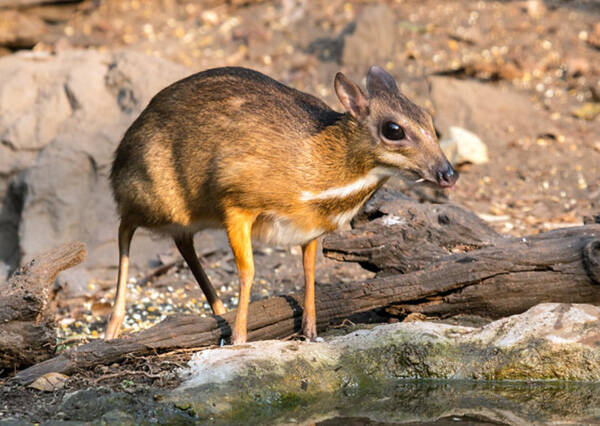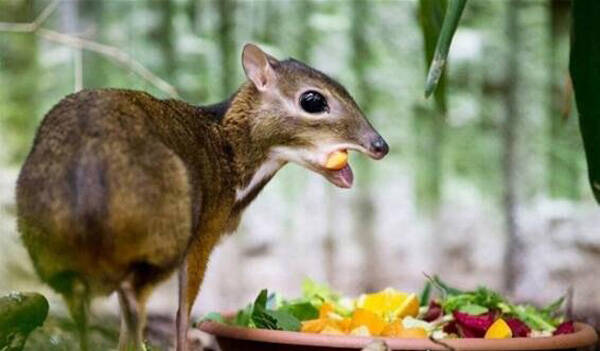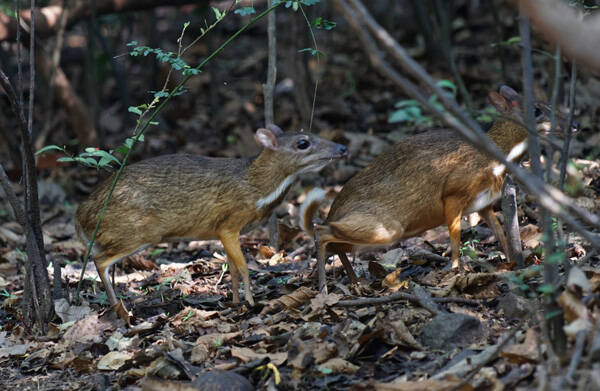Tragulus kanchil
IUCN
LCBasic Information
Scientific classification
- name:Tragulus kanchil
- Scientific Name:Tragulus kanchil,Lesser Oriental Chevrotain、Lesser Indo-Malayan Chevrotain、Lesser Malay Chevrotain、Lesser Mousedeer、Mouse Deer, Chevrotain kanchil, Petit tragul malais, Kanchil
- Outline:Ungulata
- Family:Artiodactyls Tragopanidae Tragopan
Vital signs
- length:37-56cm
- Weight:1.3-2.4kg
- lifetime:8-12years
Feature
The smallest ungulate
Distribution and Habitat
Distributed in Brunei, Cambodia, Indonesia, Laos, Malaysia, Myanmar, Singapore, Thailand and Vietnam.
Uncertain: China.
Found in primary and secondary forests in lowlands or foothills and cultivated land up to 600 m above sea level. Habitats are rivers, seasonal swamps and dry rolling hills, dominated by legume and dipterocarp vegetation. In Sabah, they also inhabit mangroves. During the day, they probably prefer to creep in canopy gaps of dense shrubs and move to higher and drier ridge areas at night. All mouse deer species are associated with forests, but there is strong evidence that the lesser mouse deer does not require primary forests or even particularly mature secondary forests. Matsubayashi et al. confirmed that it lives in large numbers in disturbed habitats.
Appearance
The head and body length of a baby mousedeer is 37-56 cm, the shoulder height is 25-30 cm, the tail length is 6-9 cm, and the adult weight is 1.3-2.4 kg. It is the smallest ungulate and has a pointed and long face. The forehead is hornless. The body and limbs are long, with an arched back and pencil-thin legs. Females tend to be slightly larger than males. The general color of the fur is reddish-brown; the degree and relative brightness of the redness varies among populations and subspecies of the species throughout its range. On several of the smaller islands, there is a tendency for melanin (black color), especially on the head, neck, and back. However, these color changes are less dramatic than in the giant mousedeer. Underparts white. There is a dark stripe on the nape, but it is less noticeable in the northern parts of the species' range. There is a prominent white stripe on the lower side of the neck. This area is directly connected to the three white stripes on the throat,
Details
Lesser Mousedeer (scientific name: Tragulus kanchil) English Lesser Oriental Chevrotain, Lesser Indo-Malayan Chevrotain, Lesser Malay Chevrotain, Lesser Mousedeer, Mouse Deer, French Chevrotain kanchil, Petit tragul malais, Indonesian Kanchil, has 30 subspecies, slightly larger than a hare. The mouse deer in Java Island and southern Yunnan, China were once considered to be a subspecies of mouse deer, with the same scientific name "Tragulus javanicus", but since 2004, Javan mouse deer (Tragulus javanicus) and Williams mouse deer (Tragulus williamsoni) have been classified as different independent species, and the lesser mouse deer has also changed its scientific name (Tragulus kanchil).

The lesser mouse deer is very similar in size, color, and markings to the Javan mouse deer (Tragulus javanicus). Body size is the most definitive identifier; some Javan mouse deer populations also have a distinctive gray neck. The distinction between the lesser mouse deer and the Williamson mouse deer (Tragulus williamsoni) has not been well studied. The chevrotain is much larger, and their ranges do not appear to overlap. The sympatric Greater Chevrotain (Tragulus napu) can be challenging to distinguish in this range. Size is often unreliable (especially when dealing with immature animals). Greater Chevrotains have more distinctive facial markings, with a long white throat stripe intermittently running down the chin and white undersides.
Both males and females of Lesser Chevrotain live in home ranges of approximately 5 ha, each with a heavily used core area. Females often have core ranges distinct from neighboring females, while males' core ranges do not overlap with those of other males; there is some evidence of territorial behavior by males. There is considerable overlap between the home ranges of both sexes.

Lesser mouse deer are generally solitary. Pairs account for less than 5% of observations in the wild. The reclusiveness and small size of the species make it a challenging species to study in the wild. When responding to danger, the first reaction is to "freeze" in place; like the greater mouse deer, the lesser mouse deer will repeatedly and rapidly stamp its feet when frightened. Data from radio-collared individuals and camera-trap images indicate that the species is most active in the morning (05:00-07:00, to 10:00) and late afternoon (15:00-18:00). The average distance traveled per day is 550 meters; daytime activities are generally in sheltered areas, with short rests in fallen tree trunks and brush. In contrast, long nighttime rests (up to 8 hours) usually occur in open forest with little brush. Food is fallen fruit (1-5 grams in size), leaves and fungi.
The mouse deer breeds year-round and is one of the fastest-breeding ungulates, with a short gestation period of 132-145 days (4.5 months) and one litter per litter. Females are able to become pregnant again within two hours after giving birth. The estrus cycle is about 14 days long. The young weigh 120-190 grams at birth and can stand within 30 minutes of birth. However, they usually "lie" in dense undergrowth and are visited by their mothers for nursing, usually twice a day. The fat content of the mother's milk is very high (26.8%), and the young grow rapidly; reaching adult size at 5 months of age. The lactating young of 21 days old easily transition to solid food after the accidental death of their mother. Sexual maturity is very early, 125 days for females and 166 days for males.

Lesser mouse deer have been historically documented to be common, and lesser mouse deer still exist in large numbers throughout their specimen-verified range, at least in non-Sundae areas, where forest degradation and fragmentation are severe and hunting is prevalent. The assumed short generation length of the species, thought to be likely within five years, also affects the assessment, because to invoke the decline criterion on the Red List, one must assume relatively high rates of decline for most species over relatively short timescales (10-15 years). Therefore, while large (local) declines may/have occurred, these may not be synchronized over sufficiently large areas.
Hunting and habitat loss occur across nearly the entire range of the Lesser Mouse Deer, but there is no clear evidence that they are suppressing populations, except in the case of conversion of previously suitable habitat to non-forest uses. Most or all range states have adequate legal basis to control both potential threats (through protected areas and regulations governing wildlife trade and hunting). The main need is presumably to effectively translate these laws into action. Without more detailed information on the current status of the species throughout its range, and investigations into the effects of high levels of hunting and habitat modification on it, more specific needs cannot be determined.
Listed in the IUCN Red List of Threatened Species in 2014 ver3.1 - Least Concern (LC).
Protect wild animals and eliminate game.
Maintaining ecological balance is everyone's responsibility!








